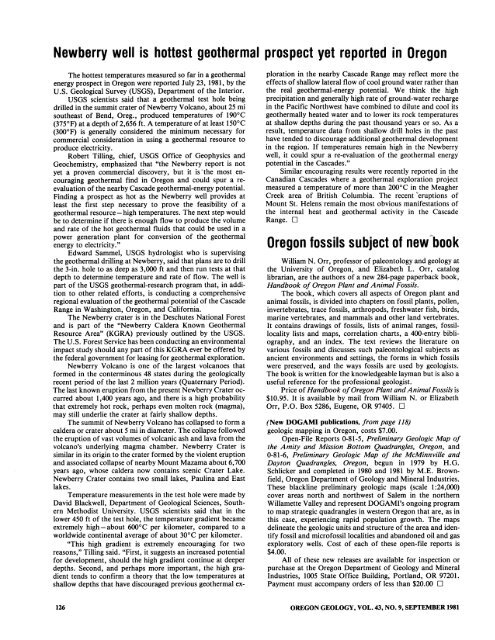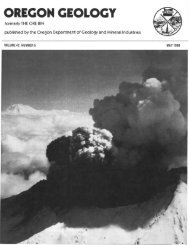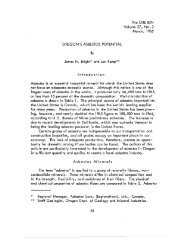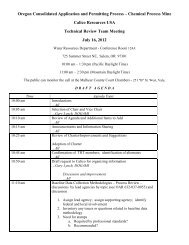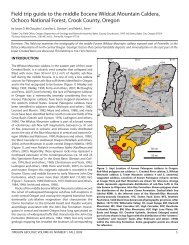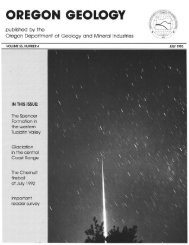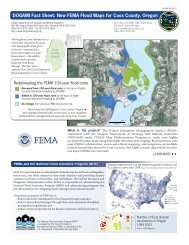Ore Bin / Oregon Geology magazine / journal - Oregon Department ...
Ore Bin / Oregon Geology magazine / journal - Oregon Department ...
Ore Bin / Oregon Geology magazine / journal - Oregon Department ...
You also want an ePaper? Increase the reach of your titles
YUMPU automatically turns print PDFs into web optimized ePapers that Google loves.
Newberry well is hottest geothermal prospect yet reported in <strong>Ore</strong>gon<br />
The hottest temperatures measured so far in a geothermal<br />
energy prospect in <strong>Ore</strong>gon were reported July 23, 1981, by the<br />
U.S. Geological Survey (USGS), <strong>Department</strong> of the Interior.<br />
USGS scientists said that a geothermal test hole being<br />
drilled in the summit crater of Newberry Volcano, about 25 mi<br />
southeast of Bend, <strong>Ore</strong>g., produced temperatures of 190°C<br />
(375°F) at a depth of 2,656 ft. A temperature of at least 150°C<br />
(300°F) is generally considered the minimum necessary for<br />
commercial consideration in using a geothermal resource to<br />
produce electricity.<br />
Robert Tilling, chief, USGS Office of Geophysics and<br />
Geochemistry, emphasized that "the Newberry report is not<br />
yet a proven commercial discovery, but it is ·the most encouraging<br />
geothermal find in <strong>Ore</strong>gon and could spur a reevaluation<br />
of the nearby Cascade geothermal-energy potential.<br />
Finding a prospect as hot as the Newberry well provides at<br />
least the first step necessary to prove the feasibility of a<br />
geothermal resource-high temperatures. The next step would<br />
be to determine if there is enough flow to produce the volume<br />
and rate of the hot geothermal fluids that could be used in a<br />
power generation plant for conversion of the geothermal<br />
energy to electricity."<br />
Edward Sammel, USGS hydrologist who is supervising<br />
the geothermal drilling at Newberry, said that plans are to drill<br />
the 3-in. hole to as deep as 3,000 ft and then run tests at that<br />
depth to determine temperature and rate of flow. The well is<br />
part of the USGS geothermal-research program that, in addition<br />
to other related efforts, is conducting a comprehensive<br />
regional evaluation of the geothermal potential of the Cascade<br />
Range in Washington, <strong>Ore</strong>gon, and California.<br />
The Newberry crater is in the Deschutes National Forest<br />
and is part of the "Newberry Caldera Known Geothermal<br />
Resource Area" (KGRA) previously outlined by the USGS.<br />
The U.S. Forest Service has been conducting an environmental<br />
impact study should any part of this KGRA ever be offered by<br />
the federal government for leasing for geothermal exploration.<br />
Newberry Volcano is one of the largest volcanoes that<br />
formed in the conterminous 48 states during the geologically<br />
recent period of the last 2 million years (Quaternary Period).<br />
The last known eruption from the present Newberry Crater occurred<br />
about 1,400 years ago, and there is a high probability<br />
that extremely hot rock, perhaps even molten rock (magma),<br />
may still underlie the crater at fairly shallow depths.<br />
The summit of Newberry Volcano has collapsed to form a<br />
caldera or crater about 5 mi in diameter. The collapse followed<br />
the eruption of vast volumes of volcanic ash and lava from the<br />
volcano's underlying magma chamber. Newberry Crater is<br />
similar in its origin to the crater formed by the violent eruption<br />
and associated collapse of nearby Mount Mazama about 6,700<br />
years ago, whose caldera now contains scenic Crater Lake.<br />
Newberry Crater contains two small lakes, Paulina and East<br />
lakes.<br />
Temperature measurements in the test hole were made by<br />
David Blackwell, <strong>Department</strong> of Geological Sciences, Southern<br />
Methodist University. USGS scientists said that in the<br />
lower 450 ft of the test hole, the temperature gradient became<br />
extremely high-about 600°C per kilometer, compared to a<br />
worldwide continental average of about 30°C per kilometer.<br />
"This high gradient is extremely encouraging for two<br />
reasons," Tilling said. "First, it suggests an increased potential<br />
for development, should the high gradient continue at deeper<br />
depths. Second, and perhaps more important, the high gradient<br />
tends to confirm -a theory that the low temperatures at<br />
shallow depths that h.ave discouraged previous geothermal ex-<br />
ploration in the nearby Cascade Range may reflect more the<br />
effects of shallow lateral flow of cool ground water rather than<br />
the real geothermal-energy potential. We think the high<br />
precipitation and generally high rate of ground-water recharge<br />
in the Pacific Northwest have combined to dilute and cool its<br />
geothermally heated water and to lower its rock temperatures<br />
at shallow depths during the past thousand years or so. As a<br />
result, temperature data from shallow drill holes in the past<br />
have tended to discourage additional geothermal development<br />
in the region. If temperatures remain high in the Newberry<br />
well, it could spur a re-evaluation of the geothermal energy<br />
potential in the Cascades."<br />
Similar encouraging results were recently reported in the<br />
Canadian Cascades where a geothermal exploration project<br />
measured a temperature of more than 200°C in the Meagher<br />
Creek area of British Columbia. The recent 'eruptions of<br />
Mount St. Helens remain the most obvious manifestations of<br />
the internal heat and geothermal activity in the Cascade<br />
Range. 0<br />
<strong>Ore</strong>gon fossils subject of new ~book<br />
William N. Orr, professor of paleontology and geology at<br />
the University of <strong>Ore</strong>gon, and Elizabeth L. Orr, catalog<br />
librarian, are the authors of a new 284-page paperback book,<br />
Handbook of <strong>Ore</strong>gon Plant and Animal Fossils.<br />
The book, which covers all aspects of <strong>Ore</strong>gon plant and<br />
animal fossils, is divided into chapters on fossil plants, pollen,<br />
invertebrates, trace fossils, arthropods, freshwater fish, birds,<br />
marine vertebrates, and mammals and other land vertebrates.<br />
It contains drawings of fossils, lists of animal ranges, fossillocality<br />
lists and maps, correlation charts, a 4OO-entry bibliography,<br />
and an index. The text reviews the literature on<br />
various fossils and discusses such paleontological subjects as<br />
ancient environments and settings, the forms in which fossils<br />
were preserved, and the ways fossils are used by geologists.<br />
The book is written for the knowledgeable layman but is also a<br />
useful reference for the professional geologist.<br />
Price of Handbook of <strong>Ore</strong>gon Plant and Animal Fossils is<br />
$10.95. It is available by mail from William N. or Elizabeth<br />
Orr, P.O. Box 5286, Eugene, OR 97405. 0<br />
(New DOGAMI publications, from page 118)<br />
geologic mapping in <strong>Ore</strong>gon, costs $7.00.<br />
Open-File Reports 0-81-5, Preliminary Geologic Map of<br />
the Amity and Mission Bottom Quadrangles, <strong>Ore</strong>gon, and<br />
0-81-6, Preliminary Geologic Map of the McMinnville and<br />
Dayton Quadrangles, <strong>Ore</strong>gon, begun in 1979 by H.G.<br />
Schlicker and completed in 1980 and 1981 by M.E. Brownfield,<br />
<strong>Ore</strong>gon <strong>Department</strong> of <strong>Geology</strong> and Mineral Industries.<br />
These blackline preliminary geologic maps (scale 1 :24,000)<br />
cover areas north and northwest of Salem in the northern<br />
Willamette Valley and represent DOGAMI's ongoing program<br />
to map strategic quadrangles in western <strong>Ore</strong>gon that are, as in<br />
this case, experiencing rapid population growth. The maps<br />
delineate the geologic units and structure of the area and identify<br />
fossil and microfossil localities and abandoned oil and gas<br />
exploratory wells. Cost of each of these open-file reports is<br />
$4.00.<br />
All of these new releases are available for inspection or<br />
purchase at the <strong>Ore</strong>gon <strong>Department</strong> of <strong>Geology</strong> and Mineral<br />
Industries, 1005 State Office Building, Portland, OR 97201.<br />
Payment must accompany orders of less than $20.00 0<br />
126<br />
OREGON GEOLOGY, VOL. 43, NO.9, SEPTEMBER 1981


